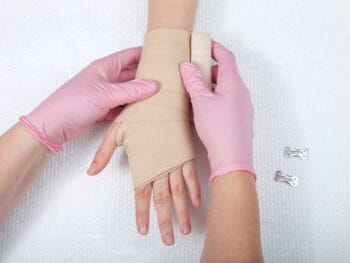
After the initial ‘phew!’ reaction, it’s time to get down to business and find out what happened, why, and, most importantly, what you can do to prevent a recurrence that could result in an injury and comp claim the next time.
The fact is, most (probably all) workplace accidents have multiple causes. Even the seemingly simple-to-explain incident likely has several underlying factors going on. By getting to the real root of the problem, you can avoid potentially costly and preventable claims.
Root Cause Analysis
Delving into the true causes of workplace injuries requires a team effort, though it doesn’t need to be all that complicated. There are a variety of frameworks for ‘root cause analyses.’ There are templates to make it easier to organize the information. Some organizations use a fishbone diagram to categorize causes to identify variation sources. Whatever system is used, several keys exist to successful root cause analysis.
Click Link to Access Free PDF Download
“13 Research Studies to Prove Value of Return-to-Work Program & Gain Stakeholder Buy-In”
- Do NOT assign blame! This is the most important aspect of getting to the real root of a problem. It’s tempting to blame someone, punish him, and move on, but that doesn’t fix the underlying problems. Root cause analysis must be done without any finger-pointing. Remember, most workplace accidents result from a confluence of contributing factors. The job of RCA is to identify and correct them.
- Ask questions. Then ask more. And a few more after that. The main questions to ask: WHY? You may feel like a 2-year-old asking ‘why, why, why’ – but this is key to getting to the crux of the analysis. For example, let’s say “Fred” fell off a ladder and was not seriously injured. It might be easy to say, ‘Well, Fred was being careless; he was in too much of a hurry, so it’s his fault.’ But asking ‘why’ will uncover important details that would prevent future such incidents. The answer to the first ‘why’ could be that one of the rungs on the ladder broke. ‘Why,’ you ask again and find out it could not hold Fred’s weight. If the rungs were designed to hold 350 lbs. and Fred weighs only 170, what was the extra weight? You discover Fred was carrying materials up the ladder, and the combined weight exceeded 350 lbs. But the company has a hoist truck for such jobs, so why was Fred not using it instead of carrying the materials himself? Turns out the hoist truck was being used elsewhere. So why didn’t Fred wait until the hoist truck was available? Because he was under the gun to finish the job on time and would have missed the deadline otherwise.
From the example, several problems come to light. There were not enough hoist trucks available, the ladder’s weight restrictions were ignored, and the deadline did not allow for the job to be done properly. Those are only some of the issues. With continued delving, there would likely be additional factors that contributed to the accident.
- Get all relevant information — and then some. In addition to the obvious details such as interviews with witnesses, examining any video footage of the incident, and speaking with the injured — or nearly injured — worker, other considerations include:
- The environment. Was the ladder properly placed on the floor? Was there anything surrounding it that might have contributed?
- Training and skill level. Did Fred have training on using the ladder? Did he understand the weight limit? Had he ever used the ladder before? Was he instructed to avoid carrying materials up the ladder (which, aside from the weight limit, could have caused him to fall)?
- Was there a specific procedure in place for using ladders? If so, was that procedure communicated to Fred and other employees? Was the procedure ever updated, and the updates communicated? Were workers known to circumvent the procedures?
- Was it properly maintained? Was there enough available? Had any relevant equipment been updated as needed?
- Human behavior. We found out Fred was in a rush due to deadline pressure. But why — what were the consequences of not meeting the deadline? Were there too few employees working on the particular job?
The Fix
Once you’ve ascertained the incident’s causes (and potential causes), it’s time to figure out corrective action. All the ‘why’ questions should end with something that indicates what and how something should be changed.
FREE DOWNLOAD: “13 Research Studies to Prove Value of Return-to-Work Program & Gain Stakeholder Buy-In”
In our Fred scenario, several things could be changed to make the organization run more efficiently and with less chance of injury. Training would be one area, for example. Fred clearly did not understand (or did not care) that carrying materials on the ladder could exceed the weight limit of the rungs. Procedures may need to be reviewed and changed to prevent people from carrying heavy or awkward items while climbing a ladder.
Equipment might need to be upgraded; perhaps an investment in an additional hoist truck would be warranted. Communication might need to be ramped up to ensure that, while meeting a deadline is important, attention to safety is more important.
Conclusion
Workplace accidents, unfortunately, happen and may result in injuries and workers’ comp claims. However, the same incident should never be repeated within an organization.
By digging deep, you can identify various factors that could lead to an injury. Taking corrective action will help ensure workers stay safe, the job gets done, and you’re not wasting money on preventable problems.

Contact: mstack@reduceyourworkerscomp.com.
Workers’ Comp Roundup Blog: http://blog.reduceyourworkerscomp.com/
©2023 Amaxx LLC. All rights reserved under International Copyright Law.
Do not use this information without independent verification. All state laws vary. You should consult with your insurance broker, attorney, or qualified professional.
















